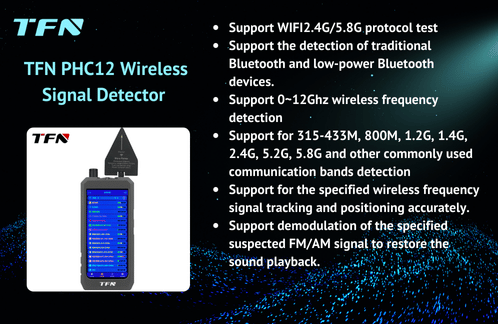Radio wave eavesdropping and corresponding preventive measures
With the rapid development of wireless communication technology, radio wave eavesdropping has become an increasingly serious security threat. This eavesdropping method uses radio equipment to intercept and decode radio signals transmitted in the air, thereby illegally obtaining information. Understanding the principles and potential hazards of radio wave eavesdropping and mastering the corresponding preventive measures are crucial to protecting personal privacy, commercial secrets and national security.
Principles of radio wave eavesdropping
Radio wave eavesdropping is based on the propagation characteristics of radio waves. Eavesdroppers use professional receiving equipment to search and monitor target signals within a suitable frequency range. Modern radio wave eavesdropping equipment is becoming increasingly miniaturized and intelligent, making eavesdropping more covert and difficult to prevent. Eavesdroppers can use these devices to intercept wireless telephones, radio communications, Wi-Fi signals, etc., and then extract useful information content.
Potential hazards
Radio wave eavesdropping seriously threatens personal privacy, commercial secrets and national security. Through eavesdropping, criminals can obtain personal privacy information for illegal activities such as fraud and extortion; they can steal business secrets and undermine corporate competitiveness and market order; they can even steal state secrets and endanger national security.
Preventive measures
1. Encrypted transmission
Encrypted transmission is an effective means to prevent radio wave eavesdropping. By encrypting the transmitted information, even if the signal is intercepted, the eavesdropper cannot decrypt and obtain the original information. Specific measures include:
Use strong cryptographic algorithms: Select widely verified strong cryptographic algorithms, such as AES (Advanced Encryption Standard), etc., to ensure the encryption strength of the information.
Regularly change the key: Regularly change the encryption key to reduce the risk of the key being cracked.
Hybrid encryption method: Combine symmetric encryption and asymmetric encryption to improve the complexity and security of encryption.
2. Limit the signal transmission range
Limiting the transmission range of radio signals can reduce the risk of being eavesdropped. Specific measures include:
Use directional antennas: By using directional antennas, radio signals are limited to a specific direction to reduce signal leakage.
Reduce the transmission power: Appropriately reduce the transmission power of radio equipment to reduce the signal coverage range.
Frequency hopping technology: Use frequency hopping technology to quickly switch signals between multiple frequencies, increasing the difficulty of eavesdropping.
3. Electromagnetic shielding
Electromagnetic shielding is a technical means to prevent the propagation of electromagnetic signals by absorbing, reflecting and attenuating electromagnetic waves. Selecting appropriate shielding equipment, such as metal cabinets, metal boxes, etc., and ensuring their sealing can effectively prevent the leakage of electromagnetic signals. In addition, the sealing of the shielding equipment should be checked regularly, and the leaking parts should be repaired in time to ensure its stable performance.
4. Use anti-eavesdropping equipment
Using equipment with anti-eavesdropping function can further improve the security of information. For example:
Jammer: Use radio jammers to generate interference signals, cover up target signals, and make it difficult for eavesdroppers to obtain useful information.
Detector: Use radio wave detectors to detect whether there are eavesdropping devices around, and find and take countermeasures in time.
Portable wireless signal detection analyzer: Such as TFN PHC12, which can detect wireless signals in full frequency band, full format, and real-time, and effectively locate and prevent eavesdropping devices.
5. Improve safety awareness and training
Improving the safety awareness of individuals and organizations is an important measure to prevent radio wave eavesdropping. Specifically include:
Regular training: Organize safety training regularly to improve employees' awareness and prevention capabilities of radio wave eavesdropping.
Establish a safety system: Establish a complete safety system, standardize the use and management of radio equipment, and reduce the risk of leakage.
Enhance confidentiality awareness: Strengthen confidentiality education, improve individuals' attention to information confidentiality, and avoid leaking sensitive information.
Through the above measures, we can effectively prevent radio wave eavesdropping and protect information security. Only when everyone realizes the importance of protecting information and takes positive actions can a complete information security line of defense be built.
In order to prevent radio wave eavesdropping, the PHC12 wireless signal detection device launched by TFN is powerful. It supports full-band detection, covers a wide range of signals from low frequency to high frequency, and can accurately capture and locate illegal eavesdropping equipment. At the same time, PHC12 also integrates infrared thermal imaging technology to assist in the detection of hidden heat sources, making eavesdropping equipment nowhere to hide. Its portable design and operation interface provide reliable security for various places.

If you are interested in TFN PHC12 wireless signal detection equipment, please contact TFN sales team:
Email: info@tfngj.com
WhatsApp: +86-18765219251
Facebook: https://www.facebook.com/tfnfate/
